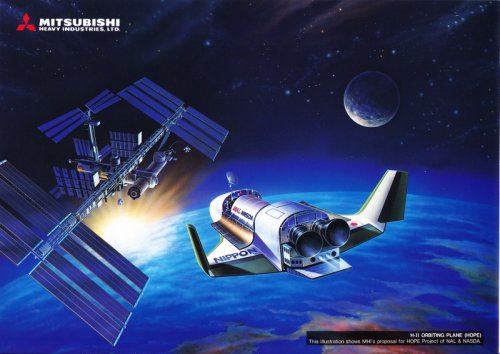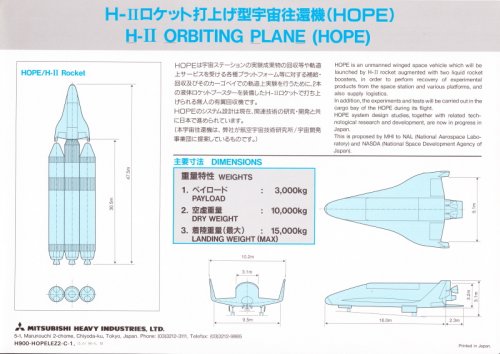You are using an out of date browser. It may not display this or other websites correctly.
You should upgrade or use an alternative browser.
You should upgrade or use an alternative browser.
Mitsubishi H-II Orbiting Plane (HOPE)
- Thread starter Barrington Bond
- Start date
- Joined
- 26 September 2008
- Messages
- 1,925
- Reaction score
- 625
Thanks.
I don't think this went through as many iterations as Hermes, but the Japanese kept drawing cockpit windows on their artwork, indicating where they wanted to go with their "unmanned" spaceplane.
I was at the JAXA DC office a few days ago and in a corner they had a model of this craft on its rocket.
I don't think this went through as many iterations as Hermes, but the Japanese kept drawing cockpit windows on their artwork, indicating where they wanted to go with their "unmanned" spaceplane.
I was at the JAXA DC office a few days ago and in a corner they had a model of this craft on its rocket.
- Joined
- 9 October 2009
- Messages
- 19,805
- Reaction score
- 10,298
I found an article on the state of the 'Winged Collection Plane' HOPE (H-II Rocket Orbiting Plane) as of February 1988. PDF pages 4 - 9.
http://www.dtic.mil/dtic/tr/fulltext/u2/a346156.pdf
From the same JPRS Report:
http://www.dtic.mil/dtic/tr/fulltext/u2/a346156.pdf
From the same JPRS Report:
Space Agency Cites Progress on Japanese Shuttle
43070005c Tokyo KYODO in English 1446 GMT 26 May 88
[Report by Tim Johnson]
[text] Sapporo, 26 May (KYODO)—National Space Development Agency of
Japan (NASDA) officials here Thursday gave a progress report on the
development of an unmanned reusable space plane, to be completed in the
next decade.
The NASDA officials, speaking at the 16th international symposium on space
technology and science, said the H-II orbiting plane (Hope), a winged
reentry space vehicle, is being developed in order to facilitate Japan's
growing involvement in space activities.
NASDA officials said the 7-9 ton reusable space plane will be launched
in the latter half of the 1990's from the Tanegashima Space Center, south
of Kyushu, by the "H-II" heavy-load launch rocket which is also under
development.
During its 4-day missions, Hope will perform the recovery of space experiment
products from the international space station and various platforms,
the officials said.
NASDA also said that in-flight experiments utilizing microgravity will be
carried out in the mini-shuttle's cargo bay.
They said the H-II launch rocket will be able to carry the cargo-laden
space plane 250 kilometers into orbit in a mere 14 minutes.
Hope will then be ejected from the H-II, maneuver gradually into the space
station's orbit, dock at the Japanese experiment module (JEM) and deposit
its cargo, the officials said.
NASDA officials said it will then pick up new cargo, de-orbit, and reenter
the earth's atmosphere for a microwave-controlled horizontal landing on a
3,000-meter runway.
Part of the mission will be controlled on the ground via a data-relay and
tracking satellite. Control will be handed over to the space station when
the spacecraft enters its command control zone.
Among the key technologies NASDA officials said they will need to develop
for the Hope project are unmanned navigation, and control methods for
rendevous-docking, reentry, and the automatic landing of the spacecraft.
Also necessary to pull off the project is research into lightweight thermal
protection for the craft during its reentry into the earth's atmosphere.
The officials explained that aerodynamic heating during reentry would bring
the surface temperature of Hope to as high as 1,700 Celcius.
NASDA also has in mind a more advanced manned space plane for the distant
future and expects the lessons to be learned from the Hope project will
contribute substantially to its development.
A NASDA official said that the reason Hope will not be manned is that such
technology is still premature in Japan and a manned craft would in any
case be too heavy for the H-II launch rocket to carry.
Although the idea of a Japanese shuttle craft has been around for a
decade, an official said, the present concept for an unmanned winged vehicle
was agreed upon by NASDA engineers last year.
This year NASDA researchers are studying the structure and equipment of
the space plane and next year Hope will enter the preliminary design phase.
The craft will be operational in the late 1990's, with three to four flights
a year estimated by the end of that decade, officials said.
The "H-I" launch vehicle entered the operational phase in 1986. Development
of the "H-II" rocket began in February 1986 and is scheduled for its
maiden launch from Tanegashima Space Station in late 1991 or early 1992.
The landing site for Hope is still under consideration, Space Agency
officials said. The Hokkaido Government is vying with other prefectures,
including Iwate and Aichi, to attract a new space base and related aeronautics
and space industries.
Hokkaido has proposed that base be built along a section of its Pacific
coastline. Prefectural officials said that the area they offer would be
large enough to accommodate shuttle construction industries, two launch
facilities for heavy launch vehicles, and extended runways with terminal
and control functions.
The northernmost prefecture will host a day-long seminar on the "Hokkaido
Space Center" on Friday, the last day of the 5-day international space
symposium.
/9604
Similar threads
-
Biggest mistakes in aviation enthusiasm. What do you now regret you threw away?
- Started by thewanderingmind
- Replies: 9
-
Earth-to-Orbit SSTO RLV projects (Martin VTO & Boeing HTO)
- Started by Stargazer
- Replies: 10
-
-


